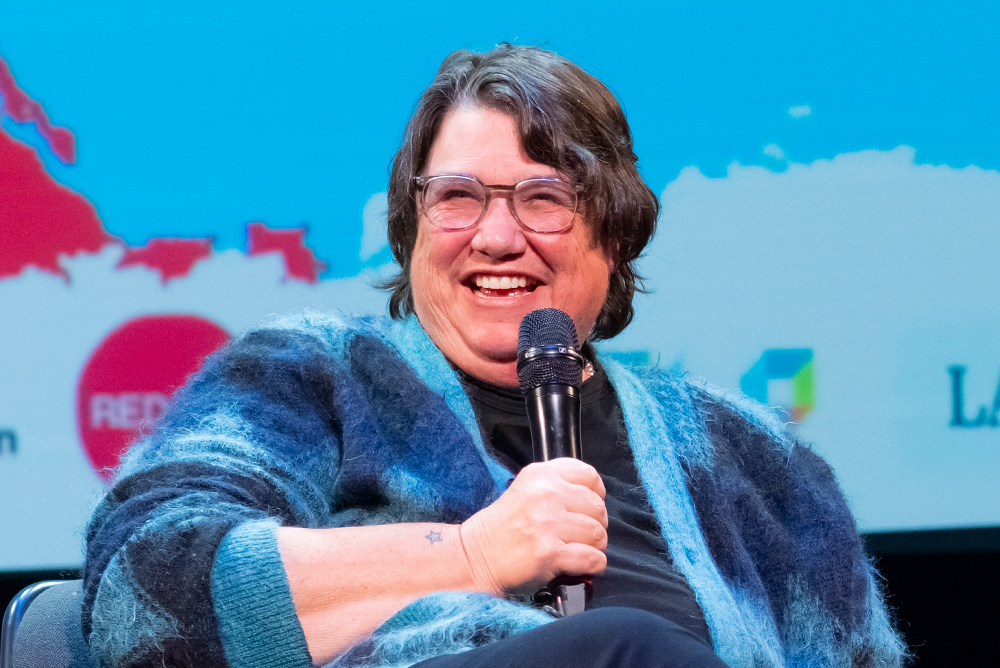
Photo by Aaron Perez.
Catherine Opie is an artist and educator working with photography, film, collage, and ceramics. Opie’s work has been exhibited throughout the United States and is held in over 50 major collections throughout the world. Before taking part in the Zócalo, Thomas Mann House, and L.A. Review of Books program “Must Artists Be Activists?”—part of the two-day conference “Arts in Times of Crises”—Opie joined us in the green room to talk about growing up in Ohio, political memorabilia, and cruising in Griffith Park.
What is the earliest creative act that you remember?
I started with making a self-portrait when I was 9. It was a serious creative act of self-representation, and it was when I told my parents I was going to be a social documentary photographer. But my first social experiment would be after moving from Ohio to Poway, California, being bored out of my mind in the ‘70s. I would stack the tumbleweeds in the middle of the road to see whether cars would go around them or if cars would actually stop, get out, and move the tumbleweeds.
You’re from Sandusky, Ohio. What’s one way that it has influenced your work?
It was a really amazing mixed community of artists as well as thinkers that my grandparents and my parents surrounded themselves with. They were adults who asked me interesting questions, always, imbuing me with a sense of responsibility and ideas at a young age.
Do you come from a family of artists?
My uncle was a painter. My grandfather owned a company called OP Craft, and my father came to work for the company and owned the largest political campaign collection, kind of in American history, which is all in the Smithsonian now. We had the “first button,” which was actually a button that George Washington wore on his coat, and that’s why they were called campaign buttons. I still have Lincoln’s announcement of his death on a ribbon; that happens to be the same day as my birthday, April 14, so my dad saved it for me. And I have the “Dewey Defeats Truman” newspaper that Truman held over his head.
What is one of your favorite places to go in Los Angeles?
There’s so many. I’ve lived in the city since 1988. But I would say that when I need peace of mind, it’s always a hike in Griffith Park, where I end up out on the precipice in the pine forest. It used to be a gay male cruising site, so that was always fun back in the ‘80s. I used to go up to the park and I used to wear a mustache and pack. And then you’d hear whispers: It’s a lesbian in a mustache! My favorite thing was this really intense straight woman one day in all her yoga clothes in the ‘90s walking there, and her lab comes bounding up out of the forest with a huge dildo in its mouth. She looked at me, and looked at her dog, and looked at me, and goes, “What do I do with it?” And I’m like, that’s on you.
You’ve worked on freeways, right? What is your least favorite freeway in L.A. County?
I’ve always lived west of Normandie, so the 405 was never my nemesis. It was really about the 10 to get across town. My son went to Crossroads. And we lived in West Adams. So I was on that friggin’ freeway back and forth, at a snail pace, hopping off and going down surface streets. I’d rather do surface streets and look around. I like jetting in and out of the city.
You’re often written about as someone who renders the invisible visible. What’s something quote-unquote invisible, that you think should be more clearly visible?
There’s so many things on that list. I think that one of the biggest fights that I’m really, really aware of right now that’s happening in relationship to American politics is the need to continue to fight for trans rights. I think gays and lesbians got a pass. And they’re kind of looked at more in relationship to being part of popular culture now, which wasn’t the truth back in the ‘80s, and ‘90s, in terms of what we’re fighting for. But I’m really, really, really worried about what’s at stake in relationship to this other archaic argument and relationship to biology and identity. I’m frightened for future children and the amount of suicides that will be taking place. And so we just have to put everything into it.



